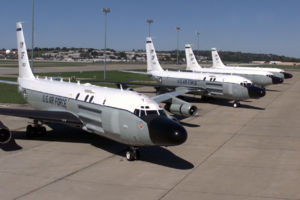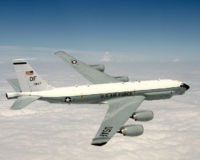PlaneSpottingWorld welcomes all new members! Please gives your ideas at the Terminal.
Boeing RC-135
| Boeing RC-135 | |
|---|---|
| An RC-135 Rivet Joint reconnaissance aircraft moves into position behind a KC-135T/R Stratotanker for an aerial refueling. | |
| Type | reconnaissance aircraft |
| Manufacturer | Boeing |
| Primary user | United States Air Force |
| Developed from | C-135 Stratolifter |
The RC-135 is a United States Air Force reconnaissance aircraft used to support theater and national level consumers with near real-time on-scene intelligence collection, analysis and dissemination capabilities.
Contents
Overview
The aircraft is an extensively modified C-135 in which the modifications are primarily related to its on-board sensor suite, which allows the mission crew to detect, identify and geolocate signals throughout the electromagnetic spectrum. The mission crew can then forward gathered information in a variety of formats to a wide range of consumers via Rivet Joint's extensive communications suite.
The RC-135 fleet is currently undergoing significant airframe, navigational and powerplant upgrades which include re-engining from the TF-33 to the CFM-56 engines used on the KC-135 Stratotanker and upgrade of the flight deck instrumentation and navigational systems to the AMP standard, including PacerCRAG. The AMP standard includes conversion from analog readouts to a digital "glass cockpit" configuration.
The current RC-135 fleet is the latest iteration of modifications to this pool of aircraft going back to 1964. Initially employed by Strategic Air Command to satisfy nationally tasked intelligence collection requirements, the RC-135 fleet has also participated in every sizable armed conflict involving U.S. assets during its tenure. RC-135s were present supporting operations in Vietnam, the Mediterranean for Operation El Dorado Canyon, Grenada for Operation Urgent Fury, Panama for Operation Just Cause, the Balkans for Operations Deliberate Force and Allied Force, and Southwest Asia for Operations Desert Shield, Desert Storm, Enduring Freedom and Iraqi Freedom. RC-135s have maintained a constant presence in Southwest Asia since the early 1990s.
All RC-135s are assigned to Air Combat Command. The RC-135 is permanently based at Offutt Air Force Base, Nebraska and operated by the 55th Wing, using various forward deployment locations worldwide.
Aircraft versions and associated missions
RC-135B
The standard as-delivered version of the RC-135.
RC-135C Big Team
Modified RC-135B aircraft used for strategic reconnaissance duties, and equipped with the AN/ASD-1 reconnaissance system. Due to the protuding fuselage sides, these aircraft were nicknamed the "Chipmunk".
RC-135D Rivet Brass
Three D model aircraft were produced for the Rivet Brass program, 60-0356, 60-0357 and 60-0362. These three aircraft were originally produced as KC-135As, but delivered without refueling booms, known as "falsie C-135As" pending the delivery of the first actual cargo aircraft in 1961. Rivet Brass flew along the northern border of the Soviet Union. At the completion of the program, the aircraft were reconverted into tankers, and are currently in the fleet as KC-135Rs.[1]
RC-135E Rivet Amber
Rivet Amber was a one-of-a-kind aircraft equipped with a large Hughes phased-array radar system. It was deployed from Shemya, Alaska, and operated together with the Rivet Ball aircraft (see below). The radar system alone weighed over 35,000 pounds and cost over USD$35 million (1960 dollars), making Rivet Amber both the heaviest C-135-derivative aircraft flying and the most expensive Air Force aircraft for its time. The system could track an object the size of a soccer ball from a distance of 300 miles, and its mission was to monitor Soviet ballistic missile launches. On June 5, 1969, Rivet Amber was lost in flight, and no trace of the aircraft or its crew was ever found (see Rivet Amber crash for details).[2]
Click on the following URL (http://www.rc135.com) for a story about Rivet Ball, Rivet Amber and Shemya, "A Tale of Two Airplanes", by Lt. Col. Kingdon R. "King" Hawes, USAF (Ret.).
RC-135M Rivet Card
This aircraft was operated by the 82nd Reconnaissance Squadron during the Vietnam War from Kadena AB, gathering ELINT as a part of operation Combat Apple. [3] There were six RC-135M aircraft, 62-4131, 62-4132, 62-4134, 62-4135, 62-4138 and 62-4139, all of which were later modified to RC-135V/W configuration.[4]
RC-135S Rivet Ball
Rivet Ball was the predecessor program to Cobra Ball, and was initiated with a single RC-135S (serial 59-1491, formerly a JKC-135A) on December 31, 1961, although the "Rivet Ball" name was not assigned until 1967. The aircraft was deployed from Shemya, Alaska. During its conversion, a large radome was installed to house the aircraft's mission-specific S band radar. Besides the over-sized radome, the aircraft was characterized by ten large portholes on the right side of the fuselage, forward of the wing, used for tracking cameras. Rivet Ball holds the distinction of obtaining the first documentation of Soviet MIRV testing in 1968. The aircraft was destroyed in a landing accident on January 13, 1969, although the entire crew was unhurt.[2][5]
Click on the following URL (http://www.rc135.com) for a story about Rivet Ball, Rivet Amber and Shemya, "A Tale of Two Airplanes", by Lt. Col. Kingdon R. "King" Hawes, USAF (Ret.).
RC-135S Cobra Ball

The RC-135S Cobra Ball is equipped with special optical instruments designed to observe ballistic missile flights at long range. The aircraft is an extensively modified C-135. There are two aircraft in service and they are part of the 55th Wing, 45th Reconnaissance Squadron based at Offutt Air Force Base, Nebraska. Cobra Ball aircraft were originally assigned to Shemya and used to observe ballistic missile tests on the Kamchatka peninsula in conjunction with Cobra Dane and Cobra Judy.
Aircraft associated with Cobra Ball
Type Registration / Serial Number
- RC-135S 61-2662 / cn 18292 - converted C-135B, NC-135B, AFSC-ASD back-up to communications satellite
- RC-135S 61-2663 / cn 18333 - converted C-135B, VC-135B
- RC-135S 61-2664 / cn 18340 - (Lost March 15, 1981 at Shemya)[6]
- JC-135B 62-4128 / cn 18468 - converted C-135B, EC-135N, RC-135X Cobra Eye, RC-135S Cobra Ball, AFSC-ASD
Click on the following URL (http://www.rc135.com) for the history of Cobra Ball by Lt. Col. Kingdon R. "King" Hawes, USAF (Ret.).
RC-135U Combat Sent
The RC-135U, or Combat Sent, is a reconnaissance aircraft in use by the United States Air Force. The aircraft is designed to locate and identify foreign land, naval, and aerial radar signals, and relay this information to intelligence communities. Distinctly identified by the antennae arrays on the nose and wing tips of the airframe, along with extended tail, there are currently only 2 Combat Sents in the USAF, both based at Offut AFB, Nebraska, under the 55th Wing. Minimum crew requirements are 2 pilots, 2 navigators, 3 systems engineers, 10 electronic warfare officers, and 6 area specialists.[7]
RC-135V/W Rivet Joint
The RC-135V/W sensor suite allows the mission crew to detect, identify and geolocate signals throughout the electromagnetic spectrum. The mission crew can then forward gathered information in a variety of formats to a wide range of consumers via Rivet Joint's extensive communications suite. The interior seats 34 people, including the cockpit crew, electronic warfare officers, intelligence operators and airborne systems engineers. All Rivet Joint airframe and mission systems modifications are performed by L-3 Communications in Greenville, Texas, under the oversight of the Air Force Materiel Command.
Under the "BIG SAFARI" program name, RC-135Vs were upgraded from the RC-135C "Big Team" configuration, itself a mission modified RC-135B (the first version delivered). The difference between the original and upgraded RC-135Vs and Ws is the different engines used.
RC-135X Cobra Eye
Another variation is the RC-135X, only one of which was created (from an C-135B Telemetry/Range Instrumented Aircraft) in the mid-1980s and used until 1993 when it was converted into an additional RC-135S/W.[3][8]
Specifications (C-135)
| RC-135 Rivet Joint | ||
|---|---|---|
| Description | ||
| Role | Reconnaissance | |
| Crew | 27 (augmented): 3 Pilots, 2 Navigators, 22 Recon Crewmembers | |
| Dimensions | ||
| Length | 135 ft | 41.1 m |
| Wingspan | 131 ft | 39.9 m |
| Height | 42 ft | 12.8 m |
| Wing area | 2,433 ft² | 226 m² |
| Weights | ||
| Empty | 98,466 lb | 44,664 kg |
| Loaded | 106,306 lb | 48,220 kg |
| Maximum take-off | 297,000 lb | 134,000 kg |
| Powerplant | ||
| Engines | Four CFM International F108-CF-201 high bypass turbofan engines | |
| Thrust | 21600 lbf | |
| Performance | ||
| Maximum speed | 500 mph (Mach 0.66) | 800 km/h |
| Combat range | 3,900 mi | 6,500 km |
| Ferry range | ||
| Service ceiling | 44,000 ft | 13.4 km |
| Rate of climb | ||
General characteristics
- Crew: 3: pilot, copilot, boom operator (4 for non-PACER CRAG aircraft)
- Length: 136 ft 3 in (41.53 m)
- Wingspan: 130 ft 10 in (39.88 m)
- Height: 41 ft 8 in (12.70 m)
- Wing area: 2,433 ft² (226 m²)
- Empty weight: 98,466 lb (44,663 kg)
- Loaded weight: 297,000 lb (135,000 kg)
- Max takeoff weight: 322,500 lb (146,000 kg)
- Powerplant: 4× (R/T) CFM International CFM-56 turbofan engines, 21,634 lbf (96 kN) each}
- Powerplant: 4× (E) Pratt & Whitney TF-33-PW-102 turbofan engines , 18,000 lbf (80 kN) each
Performance
- Maximum speed: 580 mph (933 km/h)
- Range: 3,450 mi (5,550 km)
- Service ceiling: 50,000 ft (15,200 m)
- Rate of climb: 4,900 ft/min (1,490 m/min)
Other Characteristics
- Contractor: L-3 Communications
- Mission flight crew: 21-27, depending on mission requirements, minimum consisting of 3 Electronic Warfare Officers (Ravens), 14 Intelligence Operators and 4 Airborne Systems Engineers.
- Date Deployed: Initial RC-135 conversions from 1964-1968; V/W configurations, 1981
- Inventory: Active force, 17; Reserve, 0; Guard, 0
Operators
References
- ↑ C-135 Variants Part 2 by Jennings Heilig
- ↑ 2.0 2.1 A Tail of Two Airplanes by Kingdon R. Hawes
- ↑ 3.0 3.1 82d Recon Page
- ↑ Don Logan, C-135 Series, Schiffer Publishing
- ↑ C-135 Variants - Part 1, by Jennings Heilig
- ↑ Aviation Safety's incident summary
- ↑ Official USAF fact page
- ↑ C-135 Variants - Part 3 by Jennings Heilig
- Cobra Ball - Federation of American Scientists
- RC- 135S Cobra Ball Air Force's optical intelligence collection platform - Federation of American Scientists
- Air Force Link, (2005). RC-135V/W RIVET JOINT. Retrieved December 7, 2006.
External links
- "A Tale of Two Airplanes" by Kingdon R. "King" Hawes, Lt Col, USAF (Ret.)
- Air Force Link Fact Sheet - RC-135V/W
- FAS
- The RB-47 & RC-135 in Vietnam By Bruce Bailey
Related content
Related development
Designation sequence
Related lists
Template:Active military aircraft of the United States
See also
Lists relating to aviation | |
|---|---|
| General | Timeline of aviation · Aircraft · Aircraft manufacturers · Aircraft engines · Aircraft engine manufacturers · Airports · Airlines |
| Military | Air forces · Aircraft weapons · Missiles · Unmanned aerial vehicles (UAVs) · Experimental aircraft |
| Notable incidents and accidents | Military aviation · Airliners · General aviation · Famous aviation-related deaths |
| Records | Flight airspeed record · Flight distance record · Flight altitude record · Flight endurance record · Most produced aircraft |
de:Boeing RC-135 ja:RC-135 (航空機) no:Boeing RC-135 Rivet Joint sv:Boeing RC-135 Rivet Joint

